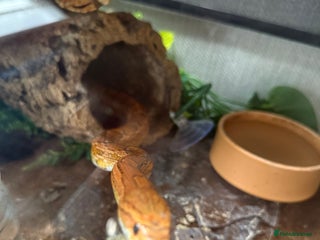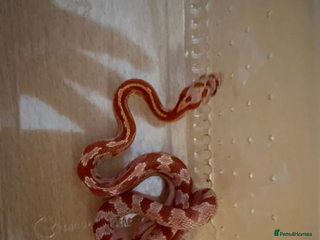Eggs Corn Snake Reptiles for sale
3 Eggs Corn Snake Reptiles for sale
The Corn Snake, also known as Cornsnake, is a popular pet snake native to the southeastern and central United States. Its name derives from the distinctive black and white checkered pattern on its belly, similar to Indian corn kernels, and its historic presence near cornfields where it hunted rodents. Physically, corn snakes typically exhibit reddish-orange blotches outlined in black along their back, with a base colour ranging from orange to brownish-grey. They usually grow between 3 to 5.5 feet in length and showcase an array of colour variations and morphs, including albino and pink corn snake variants. Known for their docile and gentle temperament, corn snakes tolerate handling exceptionally well, making them an ideal choice for beginner reptile keepers. They require a secure enclosure with proper temperature gradients from 70-88°F, regular feeding of appropriately sized frozen/thawed mice or rats, and moderate humidity levels. Corn snakes' manageable size, relatively simple care requirements, and wide availability in the UK market have made them a favourite among reptile enthusiasts. Searches like 'corn snake for sale', 'baby corn snake for sale', and 'albino corn snake' reflect their popularity in the pet trade. Overall, their friendly disposition and beautiful patterns make corn snakes highly suitable as beginner pets.

Male and female corn snakes and enclosure
Corn Snake
We have a male and female pair for sale due to not being able to give them the attention they deserve. Enclosure heat lamps and equipment all included. They do mate and produce clutches of eggs about

Baby corn snakes
Corn Snake
Need going this week as getting too big for their hatching boxes, I will be taking to reptile shop at weekend if haven’t gone. 2 baby corn snakes left, my snake laid eggs in July and they hatched in

Palmetto’s
Corn Snake
Here I have a breading pair of palmettos. Both have great temprements are handled often and feed weekly, they are 3 years old. The male has bug eyes female has had 1 clutch of eggs which she had 10 an
FAQs
Is a corn snake a reptile?
Yes, a corn snake is a reptile. It belongs to the class Reptilia and the order Squamata, making it a non-venomous rat snake native to North America.